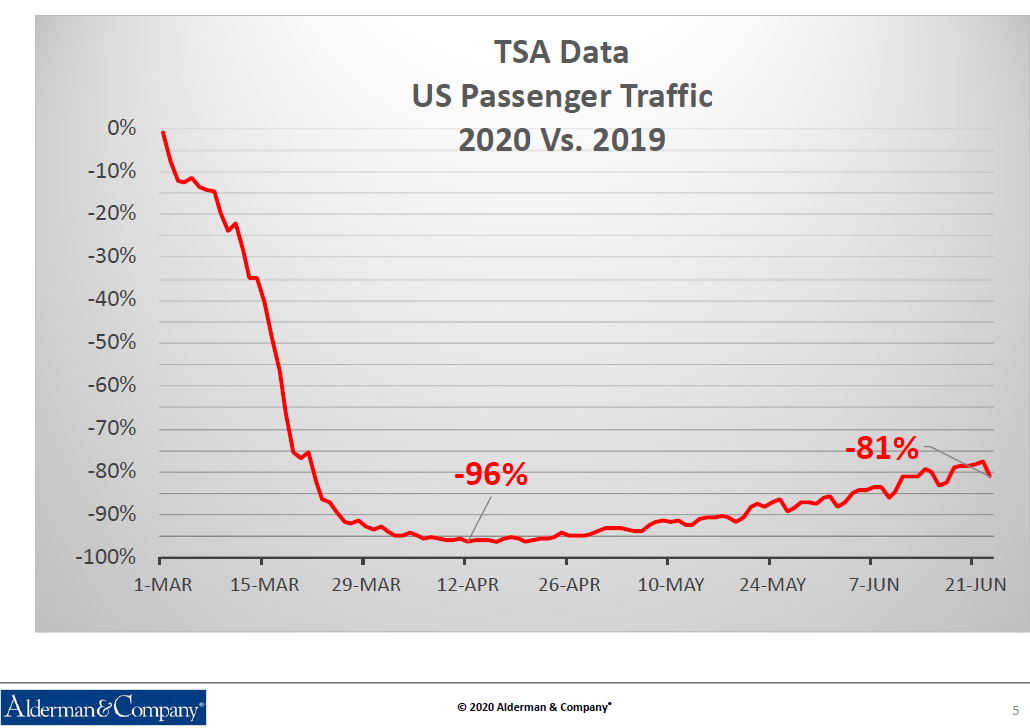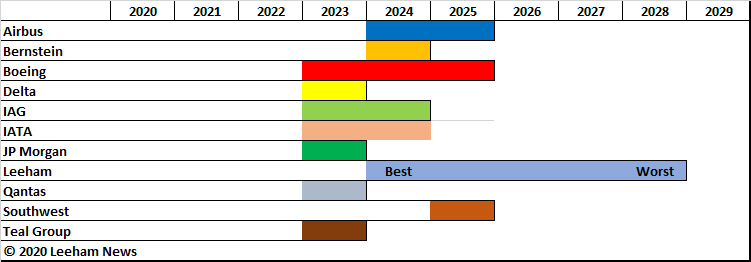Leeham News and Analysis
There's more to real news than a news release.
Pontifications: The light bulb goes on
July 27, 2020, © Leeham News: Airlines across the world are pledging aircraft, slots, airport facilities and real estate to raise money.
Some US airlines recently pledged frequent flyer programs to raise billions of dollars in debt to help carry them through the COVID-19 crisis.
Airfinance Journal last week had a podcast with United Airlines and Goldman Sachs to discuss UAL’s doing this and the larger picture.
The rush to pledge virtually everything to raise money is déjà vu all over again.
I’ve been in this business since 1979. I’ve been through the 1991 Persian Gulf War, SARS, downturns, 9/11 and the Great Recession. The impact to the airline and aerospace industry from the virus crisis is by far the worst.
As federal aid comes to end, small suppliers see “blood bath”
Subscription Required
By Scott Hamilton
Introduction
July 20, 2020, © Leeham News: As the Payroll Protection Plan of the US government nears expiration, a blood bath among small suppliers is all but certain unless an extension is approved by Congress.
This is the dire forecast by William Alderman of Alderman & Co. Alderman specializes in representing small suppliers and aftermarket companies wanting to exit the business. Small, in this case, is defined as revenues up to $100m.
Alderman told LNA that some of his clients don’t see business recovery for 10 years. This is a different metric than the one most often cited: air traffic returning to pre-COVID levels in 2023-24, by most accounts.
Summary
- Small companies need PPP extension.
- Small companies need working capital, fast.
- If neither is forthcoming, exiting the business in the other alternative.
Bjorn’s Corner: Do I get COVID in airline cabins? Part 11. Wrapup.
July 18, 2020, ©. Leeham News: It’s time to wrap our Corner series about flying during the COVID-19 pandemic.
We started the series on the 8th of May. A lot of knowledge has been gained since, about COVID-19 in general and when taking a scheduled flight.
An economic crisis on top of a medical one: Why airline traffic won’t fully recover until the mid-late 2020s
Open To All Readers
By Judson Rollins
Introduction
July 13, 2020, © Leeham News: As the world waits for the COVID-19 storm to abate, questions are growing over the duration of a demand downturn for airlines.
Many journalists and industry observers have been obsessively searching for “green shoots” indicating the beginning of a recovery, but much of this commentary misses the mark. For instance, much attention has been focused on capacity restoration in the US and China. However, little is known about the percentage of seats filled by Chinese carriers – and last week United Airlines told employees in an internal presentation that while US carrier capacity in July is back to 47% of 2019’s level, it believes industry traffic has only reached 28% and revenue just 19%.
Last month, investment research firm Bernstein published an analysis calling for narrowbody traffic to recover by 2023 and widebody traffic by 2025. This is consistent with most public forecasts from airlines, banks, and industry observers. The firm’s analysts said that single-aisle concentration in short-haul and domestic routes should see them returned to 2019 utilization sooner than twin-aisles due to reduced long-haul demand and lower demand in short-haul markets previously served by widebodies (e.g., in most of Asia).
LNA believes that 2024 is the earliest possible date for a return to 2019 global passenger traffic – and it could conceivably take until 2028. Many obstacles lie between the present situation and a full recovery: deployment of a successful vaccine (or vaccines), rollback of border restrictions, passenger confidence in the medical safety of air travel, and most importantly, restored willingness to pay by business and leisure travelers. Specific countries or regions – especially those with local vaccine production – may recover sooner, but a global recovery to pre-COVID traffic levels requires all these to happen at a global scale.
To be clear, LNA’s definition of “herd immunity” is that of the global medical community: population-level resistance to virus transmission that occurs because a large majority have been vaccinated or previously infected. This differs from an increasingly popular usage of the term in reference to the passive infection-oriented virus management approach taken by Sweden and other countries.
Summary
- Widespread uncertainty means downturn likely to outstrip previous ones in duration, magnitude
- Vaccine development may be expedited; global distribution will take longer
- Herd immunity to COVID-19 is a prerequisite to confidence in travel safety, reopening of borders
- Open borders, restored economic activity are keys to any rebound in business travel
- Consumer travel requires confidence in personal income, availability of lower fares
Pontifications: 2Q earnings reports begin this month
July 13, 2020, © Leeham News: Earnings season calls for the second quarter begin this month.
For our readers, Airbus and Boeing are the big ones.
Boeing’s earnings call is July 29. Airbus follows the next day.
A few early analyst previews were issued last week for Boeing.
Restoring capacity with the A330ceo or A330neo, Part 4
Subscription Required
By Bjorn Fehrm
Introduction
July 9, 2020, © Leeham News: Last week, we started the analysis of restoring capacity with the Airbus A330-300 or the A330-900 when reopening international traffic after the COVID-19 lockdown.
As we did with the A330-200 versus the A330-800, we fly them side by side between Paris Charles de Gaulle and Sao Polo’s Guarulhos airports. It’s a 13-hour flight with maximum freight in the cargo bays to gain revenue in addition to our part full cabin.
Will the payload-range of the A330-300 or A330-900 be sufficient to load the aircraft for maximum revenue on the route? We use our airliner performance model to find out.
Summary
- The A330-300 has gradually got more range as the Maximum TakeOff Weight (MTOW) has grown. The example highlights the limitations that still exits in this model of the A330.
- The A330-900 adds another nine tonnes MTOW over the highest MTOW A330-300. To what extent does it fix the A330-300 limitations on this route?
Pontifications: Why I won’t be flying any time soon
July 6, 2020, © Leeham News: I really, really want to return to traveling by air soon. But I don’t expect to fly until next year.
I’m not worried about being on the airplane. As LNA’s Bjorn Fehrm detailed over a series of Friday posts, the cabin purification technology scrubs the air every few minutes.
The problem is not the airplane.
It’s the people who fly.
Here’s why.
Bjorn’s Corner: Do I get COVID in airline cabins? Part 9. Stay hydrated.
July 3, 2020, ©. Leeham News: In our Corner series about flying during the COVID-19 pandemic, we examine how cabin humidity affects the risks of getting COVID-19.
The extensive research around the seasonality of flu infections gives us tips for our behavior during flights, now and when the pandemic has left us.









